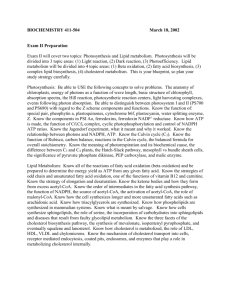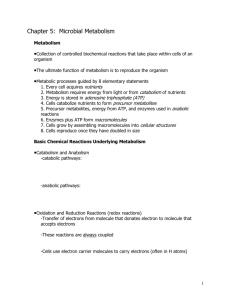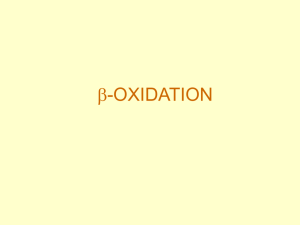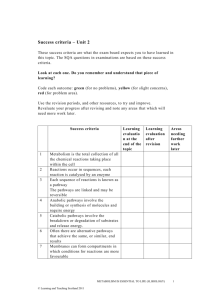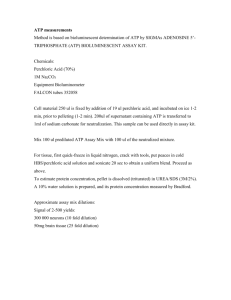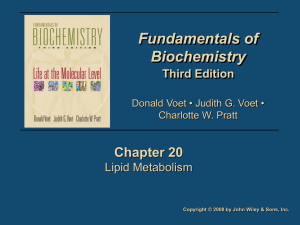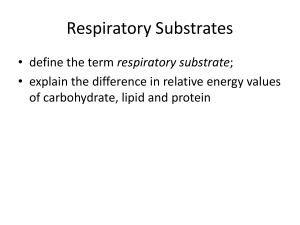Chapter 13 “Introduction to Metabolism”
advertisement
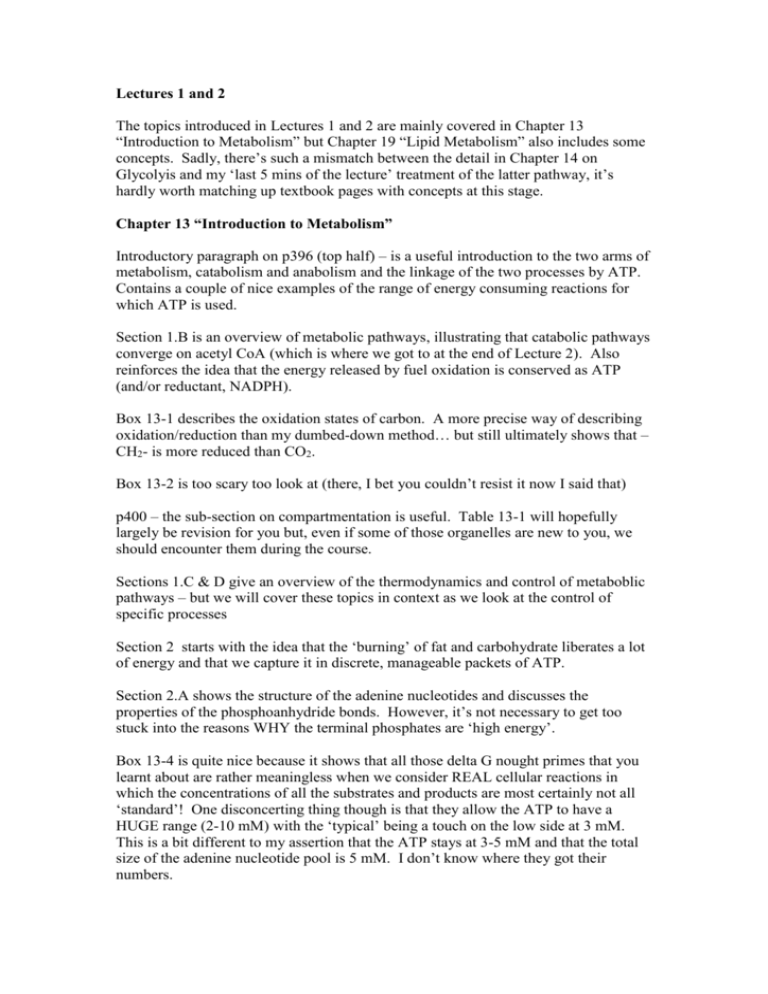
Lectures 1 and 2 The topics introduced in Lectures 1 and 2 are mainly covered in Chapter 13 “Introduction to Metabolism” but Chapter 19 “Lipid Metabolism” also includes some concepts. Sadly, there’s such a mismatch between the detail in Chapter 14 on Glycolyis and my ‘last 5 mins of the lecture’ treatment of the latter pathway, it’s hardly worth matching up textbook pages with concepts at this stage. Chapter 13 “Introduction to Metabolism” Introductory paragraph on p396 (top half) – is a useful introduction to the two arms of metabolism, catabolism and anabolism and the linkage of the two processes by ATP. Contains a couple of nice examples of the range of energy consuming reactions for which ATP is used. Section 1.B is an overview of metabolic pathways, illustrating that catabolic pathways converge on acetyl CoA (which is where we got to at the end of Lecture 2). Also reinforces the idea that the energy released by fuel oxidation is conserved as ATP (and/or reductant, NADPH). Box 13-1 describes the oxidation states of carbon. A more precise way of describing oxidation/reduction than my dumbed-down method… but still ultimately shows that – CH2- is more reduced than CO2. Box 13-2 is too scary too look at (there, I bet you couldn’t resist it now I said that) p400 – the sub-section on compartmentation is useful. Table 13-1 will hopefully largely be revision for you but, even if some of those organelles are new to you, we should encounter them during the course. Sections 1.C & D give an overview of the thermodynamics and control of metaboblic pathways – but we will cover these topics in context as we look at the control of specific processes Section 2 starts with the idea that the ‘burning’ of fat and carbohydrate liberates a lot of energy and that we capture it in discrete, manageable packets of ATP. Section 2.A shows the structure of the adenine nucleotides and discusses the properties of the phosphoanhydride bonds. However, it’s not necessary to get too stuck into the reasons WHY the terminal phosphates are ‘high energy’. Box 13-4 is quite nice because it shows that all those delta G nought primes that you learnt about are rather meaningless when we consider REAL cellular reactions in which the concentrations of all the substrates and products are most certainly not all ‘standard’! One disconcerting thing though is that they allow the ATP to have a HUGE range (2-10 mM) with the ‘typical’ being a touch on the low side at 3 mM. This is a bit different to my assertion that the ATP stays at 3-5 mM and that the total size of the adenine nucleotide pool is 5 mM. I don’t know where they got their numbers. Section 2.B describes exactly how the energy from ATP hydrolysis is used to drive otherwise unfavorable reactions. I know that some basic thermodynamics was covered in MBLG1 and, for some students, in BCHM2071, so we’ll just consider some of these issues ‘in context’ when we look at particular pathways. Section 2.Cs first couple of paragraphs emphasise the huge turnover of ATP and the need to keep up the levels of ATP – and also that ATP itself is not THE most energetic compound (a useful property for a compound that has to be made by other compounds on occasions). The remaining paragraphs on the different organic phosphates and phosphocreatine aren’t all that useful at this stage (although the stuff on phosphocreatine will be useful when we consider exercise). Similary, the section on the interconversion of adenine nucleotides (and other tri- and di-phosphonucleotides) is more useful later on than now. Section 2.D is quite fun because it shows the full structure of Coenzyme A (which I just referred to as being ‘large and charged’). That red acetyl group on the end of Figure 13-9 can, of course, be a fatty acid residue (in which case the structure would be fatty acyl-CoA and not acetyl-CoA). Note that they refer to acetyl-CoA as a ‘highenergy’ compound… which means that I should have been honest and told you that when fatty acids are ‘trapped’ by reaction with CoA, some ATP is consumed. Section 3. A shows the structure of NAD and FAD – the two electron/hydrogen grabbing molecules that we started to talk about in Lecture 2. The fact that both the nicotinamide and the flavin groups are derived from vitamins is clearly of importance. Section 3.B & C are far too ‘chemistry’ for us at the moment. Perhaps the advanced students will worry about the Nernst equation and electrochemical half-cells… who knows. Section 4 is not really relevant. As much as I’d love to talk about microarrays (my own personal area of research) I really have no idea why it is in this chapter…especially as the example given is a comparison of the transcriptomes of two cancer cell lines. Very odd. Study Exercises and Problems. None of the study exercises seem very germane at this stage. They either focus on the chemical thermodynamic principles of metabolic reactions or they cover control topics that we’ll cover ‘in context’ later on. Chapter 19 “Lipid Metabolism” p635 starts with the transport of fatty acids into the cytoplasm (but sadly neglects to mention fatty acid binding proteins or transporters) and, by the time you get to the diagram on p638, you’ll have a pretty good idea of the molecular processes behind the 2-carbon split that occurs as FAD and NAD rip out hydrogens from fatty acids. Don’t go further than this at this stage.
